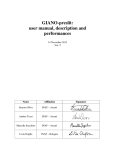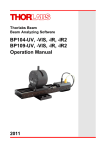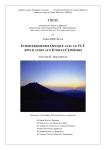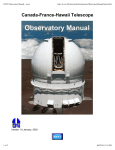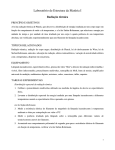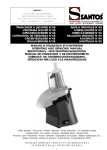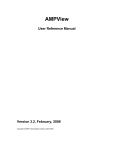Download GIANO-preslit: user manual, description and performances
Transcript
GIANO-preslit: user manual, description and performances 15 Sep 2013 INAF-OSSERVATORIO ASTROFISICO DI ARCETRI TECHNICAL DOCUMENT FOR GIANO-preslit: user manual, description and performances 15 September 2013 Ver, 1 Name Affiliation Ernesto Oliva INAF – Arcetri Andrea Tozzi INAF – Arcetri Marcella Iuzzolino INAF – Arcetri Livia Origlia INAF - Bologna Signature Page 1 of 43 GIANO-preslit: user manual, description and performances 15 Sep 2013 Page 2 of 43 Modification Record Version Date Author 1 15 Sep 2013 E. Oliva et al. Section/Paragraph Reason/Remarks affected First release of the all document GIANO-preslit: user manual, description and performances 15 Sep 2013 Page 3 of 43 Content Content ................................................................................................................................................ 3 1 Scope............................................................................................................................................ 4 2 Introduction ................................................................................................................................ 4 3 The fibers-telescope interface ................................................................................................... 5 3.1 Opto-mechanical design....................................................................................................... 6 Light path description in the downstream working mode............................................................ 9 Light path description in the calibration mode. ......................................................................... 11 Light path description of the guider camera .............................................................................. 12 Light path description of the Fiber Viewer camera ................................................................... 14 4 5 3.2 Observing modes ............................................................................................................... 15 3.3 Giano’s interfaces description............................................................................................ 17 3.4 Bill Of Optical Material of OIG box................................................................................. 19 3.5 Dismounting/Mounting procedure. .................................................................................... 20 3.6 Electronic plan. .................................................................................................................. 22 The fibers-spectrometer interface .......................................................................................... 23 4.1 Opto-mechanical design..................................................................................................... 23 4.2 Slit centering mechanism ................................................................................................... 28 4.3 The Image Slicer. ............................................................................................................... 29 4.4 Fiber scrambler mechanism ............................................................................................... 32 4.5 Star-centering mechanism .................................................................................................. 33 4.6 Bill Of Optical Material of Preslit Giano box ................................................................... 34 4.7 Preslit GIANO box Dismount/Mount Procedure. .............................................................. 35 Measurements of efficiency ..................................................................................................... 36 5.1 The absolute efficiency of the GIANO spectrometer ........................................................ 36 5.2 The end-to-end absolute efficiency of GIANO.................................................................. 39 5.3 Efficiencies with the telescope and looking directly at the sky ......................................... 41 GIANO-preslit: user manual, description and performances 15 Sep 2013 Page 4 of 43 1 Scope This document describes the new fibers-interface of GIANO, which was mounted and tested at the TNG telescope during the commissioning runs in 2013. It also includes the maintenance procedures and summarizes the results of the measurements of efficiencies performed during the same runs. 2 Introduction In the first Giano commissioning on July 2012 the spectrograph was located in the TNG Nasmyth A and was positioned on the floor of the rotating building, detached from the telescope. As a consequence Giano is fed via special fibers with extended transmission to the infrared wavelengths which are interfaced to the telescope at the ex-OIG focus. The interface is mounted on a quasi-gravity-invariant structure consisting of a horizontal bench fixed to a vertical bearing attached to the ex-OIG flange. At first the fiber-telescope interface of GIANO was designed with minimal size, resulting in a noneasily-adjustable matching. After the 2012 commissioning a new interface has been introduced: the new preslit system is composed by two different optical benches, one mounted on the OIG Telescope interface, and the other mounted directly on one side of the Giano Cryostat. They have been realized mainly using commercial components in particular for the optomechanical devices, this because of the short time used for the assembling. This system has some new features with respect to the previous one: PRESLIT OIG BOX: 1) a full controlled telescope's optical axis - fiber's axis alignment thanks to the available visible pupil check, the adjustable optical components inside the OIG board and the possibility to align the whole OIG box using seven external micrometers realizing a full 3D alignment system. 2) The possibility to look at the fibers position on the guider camera. This is the upstream mode that is referred to the light going from a calibration source to the guider camera through the fibers (in order to check the fiber alignment with respect to the telescope's axis). PRESLIT GIANO BOX 1) a full controlled Giano optical bench - fiber's axis alignment thanks to the adjustable optical components inside the Giano side box board and the possibility to align the whole box using seven external micrometers realizing a full 3D alignment system. 2) The possibility to increase the efficiency using a slicer prism 3) The possibility to look at an intermediate focus before the beam enters in the cryostat. GIANO-preslit: user manual, description and performances 15 Sep 2013 Page 5 of 43 3 The fibers-telescope interface The fiber-telescope interface is realized by the Preslit OIG Box, described in the following paragraphs. First of all it is important to remember that the two Preslit boxes are optically connected by a couple of fibers optics, assembled as shown in the following design, in the same SMA connector. Fig. 1 Design of the custom fiber optics patch cord. Core diameter of each fiber is 84 micron (1 arcsec in sky). Distance between centers is 250 micron (3 arcsec in sky). The two fiber termination are placed vertically with respect to the Preslit OIG box optical bench plane: this will be important for the definition of the observing modes as described in chapter 3.2 “Observing modes”. It is important to say that the core dimension is 1 arcsec in sky and that the distance between centers is 3 arcsec in sky. GIANO-preslit: user manual, description and performances 15 Sep 2013 Page 6 of 43 Fig. 2 Optics of the Preslit OIG box. 3.1 Opto-mechanical design Description of the board optical parts, size and weight are below reported. The OIG box is based on a commercial 60X30 cm aluminum optical bench by Thorlabs onto which the optics are positioned as visible in Fig. 3. The opto-mechanical design is based on commercial elements including, in particular, three off-axis parabolic mirrors which only recently became available as standard, off-the-shelf optical elements. In Fig. 4 the alignment micrometers are visible. Fig. 3 Inventor design of the Preslit OIG box. FM are Folding plane Mirrors, P are parabolic mirrors, BS is the dichroic Beam Splitter, ND the neutral Density sector wheel, DM the D shape Mirror, L1 is a lens, BF a Pass Band filter. In dashed red arrow the input of the fiber calibration light, in green the science output fiber. GIANO-preslit: user manual, description and performances 15 Sep 2013 Page 7 of 43 Fig. 4 Alignment details of the Preslit OIG box. External micrometers are visible and for each ones the correct nominal position is given in Tab. 1 The positions of the micrometers are the following: Description Acronym Value [mm] Front Vertical Front Orizzontal Front Focus Back Orizz. Left Back Orizz. Right Back Vert. Left Back Vert. Right FV 11,43 FO 6,10 FF 7,21 BOL 6,83 BOR 19,12 BVL 11,50 BVR 11,50 Tab. 1 Micrometer positions of the Preslit OIG Box on 2 Aug. 2013. Position and identification names of the micrometers are reported in Fig. 4 The mounted size of the Preslit OIG box are 600mm x 300mm x 120 mm and its weigh is 20kg: this box can be easily removed and it is the part of the system that will be aligned on the telescope f/11 beam using the micrometers. The total weight of the interface, including the flange-adapter and support system, is about 39kg. In Fig. 5 and Fig. 6 are represented the conceptual designs of the Preslit OIG Box. The optical design is composed by at least four optical designs, described in the following paragraphs. This because of the different operating modality we have for this board. GIANO-preslit: user manual, description and performances 15 Sep 2013 Page 8 of 43 Fig. 5 Conceptual plot of the Preslit OIG box in the downstream modality. Dashed lines represent motorized axis. Fig. 6 Conceptual plot of the Preslit OIG box in the upstream modality. P3 is an identical off axis parabola of P2. In Fig. 5 the observing configuration in which one fiber looks at the sky and the other looks at the calibration lamp is schematically shown. In Fig. 6 the Upstream modality is represented: an Infrared LED is remotely switched on in the Preslit Giano Box and placed in front of the fibers using a motorized system. This is Fiber Viewer modality and is described in “Light path description of the Fiber Viewer camera” paragraph. In Fig. 5 and Fig. 6 the dashed lines represent the movable axis, remotely controlled, that are: 1) The motor stage M-111 for the position regulation of the D shape mirrors located on f/11 TNG focus based on a Mercury PI commercial driver, 2) The motor stage for the Neutral Density filter wheel, based on a custom step motor driver, 3) The solenoid to insert/remove the light stop for the fiber viewer. The Zemax designs for the different optical path are below listed and described. GIANO-preslit: user manual, description and performances 15 Sep 2013 Page 9 of 43 Light path description in the downstream working mode The F/11 beam from the telescope is collimated and re-imaged at the fiber F/4.9 focus using two off-axis parabolae and two bending mirrors. The output F/4.9 beam has a diffraction-limit optical quality and is pseudo telecentric: nominally the exit pupil in Zemax design is located 151 mm far from the focus and has a diameter of 31 mm, but the chief ray angle for a field of 2 arcsec in sky far from on axis one is only 3,5 arcmin. This comport a lateral shift of the pupil of 0.017%. A dichroic beam-splitter on the collimated beam reflects the blue (<850nm) light to the guider. An image of the TNG pupil is accessible before the dichroic as visible in the photo on this side taken during daytime placing a piece of paper in front of the dichroic. The dome was opened during the test so the primary mirror and spiders are well visible. Fig. 7 Zemax optical design of the downstream mode. P1 and P2 are commercial parabolas, BS is the dichroic beamsplitter, FM are folding mirrors. (File: TNG_oig_ver6_fiberin_tzz_1.zmx) In the Fig. 7 is shown the design of the downstream mode. The first off axis parabola, P1,is placed 152.4 mm after the f/11 TNG focus so the output beam is collimated by the P1 parabolic mirror, having an Effective Focal Length (EFL) of 152,40 mm with an error of ±1%. The beam is folded and a pupil image is placed in the dichroic beam splitter. So P1 realizes a real image of the primary mirror on the beam splitter. The second off axis parabola, P2, has an EFL of 67,74 mm (with an error of ±1%) and generates and f/4.9 output beam focalized on the input fiber termination. The scale of this focus is 83,4 micron/arcsec in sky and the whole system is diffraction limited in the full wavelength range 900-2400 nm as shown in the following figure, Fig. 8. GIANO-preslit: user manual, description and performances 15 Sep 2013 Page 10 of 43 Fig. 8 MTF of the fiber in optical path The following table shows the scale factor of the different foci present in Preslit OIG Box: Focus Position f/number Scale [micron/arsec sky] TNG focus on OIG flange Fiber In on ZBLAN fibers CCD Guider plane f/11 f/4,9 f/4,9 187,0 83,4 83,4 Tab. 2 Focus scale factor for the Preslit OIG box The magnification factor from f/11 TNG focus to f/4.9 Fiber focus is -2.24. GIANO-preslit: user manual, description and performances 15 Sep 2013 Page 11 of 43 Light path description in the calibration mode. The calibration mode optical design is represented in Fig. 9. A fiber optics of 400 micron core diameter in ZBLAN feeds the Preslit OIG box: the calibration NE-U and Halogen lamps are in the box located into the rackmount, placed on the Nasmity A platform. The light is refocused by L1 (commercial CaF singlet of 15 mm focal length) on the f/11 nominal position of the TNG focus where a D shape mirror is located and can be easily positioned using a remote controlled motor linear stage (M111 of MICOS/PI). Then the light follows the same optical path of the natural star and is focused on the fiber input terminations. Fig. 9 Zemax optical design for the Calibration mode. P1 and P2 are commercial parabolas, BS is the dichroic beamsplitter, FM are folding mirrors, DM is D shape couple of mirrors remotely controlled. (File: TNG_oig_ver6_calibration on fibers_tzz_1.zmx) The M111 MICOS/PI translation stage controls the position of two D shape mirrors that are custom assembled to permit different observing operating modes as described in the following chapter. The final f/number of the calibration beam is approximately f/4 with a scale factor of approximately 1. The nominal magnification from the fiber source (400 micron fiber) to the final focus is equal to one: so the input terminations of the scientific ZBLAN fiber can be fed by the incoming light from the calibration light source, that can be chosen between the Ne-U lamp and the Halogen lamp. The calibration sources are located into the Preslit Rackmount. GIANO-preslit: user manual, description and performances 15 Sep 2013 Page 12 of 43 Light path description of the guider camera The Guider is based on a CCD camera made by Finger Lake based on a CCD having 512X512 pixel array of 20 micron pixel size. The focal camera is realized using an off axis parabola (P3) identical to P2. The scale on CCD is 83 micron/arcsec on sky that it means there is a magnification of 0.44 from f/11 TNG focus to the focus on the guider CCD. The nominal FOV of the guider is 2X2 arcmin, but during sky observation the FOV is partially vignetted by the D shape Mirror support located on the f/11 TNG focus and necessary to change the observing mode. Fig. 10 Zemax optical design for the Guider branch. P1 and P3 are commercial parabolas, BS is the dichroic beamsplitter, FM ais a folding mirror. ND is a neutral density filter wheel. BF is a passband filter. (file: TNG_oig_ver6_guider_tzz_1.zmx) After the Dichroic Beam Splitter there are positioned a BandPass filter (BF) and a multi position Neutral Density Wheel, having the following ND values: 0.1, 0.2, 0.3, 0.4, 0.5, 0.6, 1.0, 2.0, 3.0 and 4.0. The transmission can be calculated by T=10-D. The non perfectly parallelism of the two surfaces that compose the grey filters, have been measured and it is negligible; so the translating effect of the stars measured by the guider is not affected by the ND filter wheel and no look-up table is necessary. Before the ND filter wheel a Bandpass Filter (BF) is placed on the optical path. It has been realized using two commercial filters of thorlabs: cut-on FEL 750, cut-off FES 950. Neutral density values and their motor step positions are the following: Neutral density name Motor step value Neutral density name ND 0.1 1535 ND 0.6 Motor step value 735 GIANO-preslit: user manual, description and performances ND 0.2 ND 0.3 ND 0.4 ND 0.5 95 255 415 575 ND 1.0 ND 2.0 ND 3.0 ND 4.0 15 Sep 2013 Page 13 of 43 895 1055 1215 1375 Tab. 3 Neutral Density values Fig. 11 MTF of the guider system optics We are intentioned to modify the Bandpass Filter to increase the throughput on the guider especially for giant red stars. This can be easily done changing the filters (in particular the FEL one) that are mounted on a standard Thorlabs mechanical fixed mount. GIANO-preslit: user manual, description and performances 15 Sep 2013 Page 14 of 43 Light path description of the Fiber Viewer camera The Fiber Viewer is based on the same CCD camera used by the Guider. On the optical beam in the Giano Preslit Box an IR LED can be inserted and switched on varying the intensity. The light is partially collected into the two ZBLAN fibers and reaches the Preslit OIG box using the same fibers normally used for the scientific measures on the sky. The outgoing light from these two fibers is collimated by P2 parabolic mirror on the FM2 folding mirror. Than is partially reflected by the Beam Splitter (BS) and totally reflected back again from FM3 folding mirror. This mirror is normally covered by a black stop placed in front of it, but this cover can be remotely controlled and removed. The light from FM3 passes through the beam splitter BS and follows the same optical path of the incoming light from star, normally reflected by the dichroic beam Splitter BS. On Finger Lake CCD (FLI CCD) an image of the two fibers is generated on the CCD Guider, simultaneously or not with the scientific target. Fig. 12 Zemax optical design for the Fiber Viewer branch. P2 and P3 are commercial identical parabolas, BS is the dichroic beamsplitter, FM3 is a folding mirror. ND is a neutral density filter wheel. BF is a passband filter. (File: TNG_oig_ver6_fiber viewer_tzz_1.zmx) The image of the two fibers is reimaged by the two identical off axis parabolas P3 and P2 on the CCD guider and so the magnification factor is equal to one. The position of the two fiber images can be recorded and that coordinates on the CCD, F1(x1;y1) and F2(x2;y2), will represent the correct position in which to align the scientific target under investigation during scientific observation. This is true provided that the folding mirror FM3 has not changed position in the course of time, otherwise a recalibration procedure will be necessary and an offset to the two CCD pixel coordinate F1 and F2 will be necessary. GIANO-preslit: user manual, description and performances 15 Sep 2013 Page 15 of 43 Fig. 13 MTF of the Fiber Viewer system optics 3.2 Observing modes According to what previously said and referring to the figures (Fig. 3, Fig. 5, Fig. 6), we now illustrate the Observing Modes (OM). The inputs of the two optical ZBLAN fibers are vertically disposed in the Preslit OIG box. This fact permits to operate in different observation modality only moving the translation stage M-111 on which the two D shape mirrors are mounted as visible in the detailed design/photo of Fig. 14 and if Fig. 15. Fig. 14 Detailed view of the D mirror, placed on the f/11 TNG focus. Mirrors are vertically mounted and the shape of these mirrors is like a D where the straight side is very well worked to generate a knife. Two of these mirrors have been mounted on the same GIANO-preslit: user manual, description and performances 15 Sep 2013 Page 16 of 43 mechanical mount using Millbond optical glue: the two parallel sides form a slit of about one millimeter located at the nominal f/11 TNG focus. The tilt regulations of the mechanical mount on which the D mirrors are placed are useful to align the outgoing calibration beam from lens L1, to be overlapped to the f/11 TNG telescope chief ray. Fig. 15 The two D mirrors are glued on an iron ring to take them in position one with respect the other. Changing the value of M-111 linear stage position it is possible to have the following OMs: 1) M-111 @ 0 mm (home position name: CC 1+2 calib) The Light from sky is blocked by the back surface of the D shape mirrors. In this position the light from calibration input can be reflected by the bottom D shape mirror to the outgoing- fibers and the guider, along the input optical axis of the Preslit OIG box. 2) M-111 @ 1,7 mm (position name: CB star fiber down + calib fiber up) The bottom fiber is fed by the light from sky while the top fiber is optically conjugated to the calibration beam. It is important to remember that the two parabolas M1 and M2 generate an inverting optical system (magnification from focus is 0.44): so the top fibers looks at the bottom f/11 focus. 3) M-111 @ 2,7 mm (position name: AC star fiber up + calib fiber down) The top fiber is fed by the light from sky while the bottom fiber is optically conjugated to the calibration beam. 4) M-111 @ 15 mm (position name: AB 1+2 sky) The D shape mirrors are placed in the bottom as far as possible from the mechanical axis of the input hole. The whole sky is visible by the guider: as already said the nominal FOV in this condition is 2X2 arcmin but it is partially vignetted by the mechanical mount that supports the D shape mirrors. GIANO-preslit: user manual, description and performances 15 Sep 2013 Page 17 of 43 3.3 Giano’s interfaces description. In the following figure (Fig. 16) it is represented the general Giano spectrometer interface and the internal cabling scheme. All the interfaces with TNG are represented and are listed with letters a,b,…,h,i and they are of different types: electrical (blue and yellow), gas (grey and brown) and light (red). Fig. 16 Giano general interface scheme: electrical (blue and yellow perimetric boxes), gas (grey, brown and green boxes) and light (red) . The Giano instrumente internal cabling is represented, too. Below in the table the interfaces between Giano instruments and the TNG structure are listed. In Fig. 17 the photo shows the locations of the listed interfaces. GIANO-preslit: user manual, description and performances 15 Sep 2013 Page 18 of 43 Name Type Giano device TNG location a1 Ac power line 220 Vac two phases Cryogenic Rackmount a2 AC power line 380 Vac try phases Giano Cryostat a3 AC power line 220 Vac two phases b Ethernet RJ45 connection c Ethernet RJ45 connection d Input Dry air Silicon tube Giano Cryostat e Out line for N2 Metal tube Giano cryostat f Out line pump Rotative pump jacket Giano cryostat g Out line for N2 Metal tube Giano cryostat h Input N2 plant Standard cryogenic tube Giano cryostat i f/11 beam Nasmyth A wall Nasmyth A wall Nasmyth A wall Nasmyth A wall Nasmyth A wall Nasmyth A wall Nasmyth A wall Nasmyth A wall Nasmyth A platform Nasmyth A platform Nasmyth A derotator Letter color Preslit Rackmount Preslit Rackmount Cryogenic Rackmount Light from tertiary mirror. Preslit OIG M25X1 tap is provided. side Tab. 4 Giano’s Instrumente interface list. Colors are referred to Fig. 5. Fig. 17 Locations of the Giano’s interfaces with TNG are shown. GIANO-preslit: user manual, description and performances 15 Sep 2013 Page 19 of 43 3.4 Bill Of Optical Material of OIG box In the following Table the bill of material of the optical components for the Preslit OIG Box is listed: Acronym Manufacturer Type/model P1 Thorlabs MPD25476290-P01 P2 Edmund 63-193 P3 Edmund 63-193 BS Pecchioli Research + Tafelmeier Custom FM1,FM2, FM3 Thorlabs PF10-03-P01 BF Thorlabs FEL 750 + FES 950 ND Thorlabs NDC-100S-4 CCD FLI -- L1 Thorlabs LB5766 DM Thorlabs + Pecchioli Res. PFD05-03-M01 Calibration Fiber IR Photonics Custom Scientific Fiber IR Photonics Custom Description notes # 1” Silver protected parabola 1” gold protected parabola 1” gold protected parabola EFL = 152,4 mm Off axis angle = 90° (same of Edmund 63196) 1 EFL = 67,74 mm Off axis angle = 60° 2 EFL = 67,74 mm Off axis angle = 60° 3 Coating Tafelmeier X/PELPF1 (1st surf.) + AR(2nd surf.) 4 2” Infrasil 302 coated 1” Silver protected Long pass filter + short pass filter Step variable grey filters 5 Mounted in series on the same mechanical support 6 Ten position rotary sectors 7 -15 mm CaF singlet lens D shape gold mirror 2 ZBLAN core diam. 85 micron 1 ZBLAN core diam. 400 micron 8 9 Assembled by Pecch. Resea. 10 SMA custom connectorized 11 SMA connectorized 12 Tab. 5 Bill of material for the optical components for the Preslit OIG Box GIANO-preslit: user manual, description and performances 15 Sep 2013 Page 20 of 43 3.5 Dismounting/Mounting procedure. The Preslit OIG Box is aligned on the f/11 TNG beam using the seven micrometers described above. After this the mechanical blocks (see Fig. 18) can be inserted to avoid the possibility of accidental movements of the box itself especially during the rotation of the OIG flange. Fig. 18 Figure shows the mechanical block to lock the OIG box. The dismount procedure of the OIG Box is the following: 1) first of all it is necessary to remove the two mechanical blocks. It is important to note that there is no need to move the micrometers from their original positions. 2) it is necessary to open the cover of the OIG box removing the four corner screws on the top side wall. 3) The OIG Box has six functional connections: 4 electrical cables and 2 optical fibers that will be necessarily unplugged, as shown in Fig. 19. Four of these six connection are externally located and can be easily removed on the back side wall of the OIG Box. But two of these connections, the Science Fiber Optic and the PI M111 Motor Cable, have the connectors located INTO the OIG box. In Fig. 19 their positions are pointed out by red triangles. IMPORTANT NOTE 1: the science fiber is NOT symmetrical, so if you unplug the SMA connector you lose the position of the two fibers that has to be vertically disposed with respect to the optical bench. The female SMA connector is placed on a standard post mountable XY translation stage (Thorlabs model LM1XY) that has the possibility to adjust the rotation angle of the fiber after it is mounted and screwed. When you will remount the OIG box this is the correct device to rotate to find the correct alignment of the two Science fibers: looking at the FLI CCD used in the Fiber Viewer configuration, you have to place the image of the two fibers vertically in the same position you have before starting the dismount procedure. GIANO-preslit: user manual, description and performances 15 Sep 2013 Page 21 of 43 IMPORTANT NOTE 2: the motor cable of PI M-111 linear stage has a standard DB15 connector. It is located under the Traco Power downconverter visible in Fig. 19, that MUST be removed in order to have direct access to the DB15 connector. Fig. 19 Connection cables and fibers of the OIG box. 4) Now the OIG Box can be removed. It is 20 Kg heavy and first of all you have to uplift of 12 centimeters the box in the front zone. This to unplug the mechanical joint located in the bottom side that is the ONLY mechanical constrain of the OIG Box. The Joint is free to move itself and pay attention not to lose it! In any case it is an RS components: 689-215. 5) The OIG Box can be run on the two vertical micrometer. So doing the box can be removed by its support and alignment structure. The mounting procedure is the same of the dismount one, but from the last point to the first one: great attention MUST be paid to the IMPORTANT NOTE 1, few rows above. GIANO-preslit: user manual, description and performances 15 Sep 2013 Page 22 of 43 3.6 Electronic plan. In the following figure the electronic cabling is sketched. Fig. 20 Schematic representation of the electronic cabling The electronic Preslit Rackmount contains all the electronics needed for the preslit. It is composed by : A. B. C. D. E. F. PC Xill Lantronix Ethernet-RS232 portserver Calibration box Ne-Uranium driver lamp Electronic box Power supplies box Below a spare volume for future devices. GIANO-preslit: user manual, description and performances 15 Sep 2013 Page 23 of 43 4 The fibers-spectrometer interface The interface between the science fiber and Giano spectrometer is realized in the Preslit Giano Box, visible in Fig. 17 and Fig. 23 (Inventor 3D design). The box has the following dimensions: 606 X 456 X 140 mm and has a mass of 25 Kg. The whole system, composed by the box itself and the support structure, is attached to the Giano input flange by 12 M6 screws. The total mass is 35 Kg. Fig. 21 The inner of the Preslit Giano Box. 4.1 Opto-mechanical design The 3D optomechanical design in visible in Fig. 23 and the Zemax design in Fig. 25. The red beam is the backup optical beam and is not described in the present document because it is currently not used: it is an optical path that can be considered in case that the Image Slicer is not adopted. In fact the more complexity of the operative optical beam (in green in figure) is related only to the introduction of this Image Slicer (SLC). The starting point of the design of the Fiber-Spectrometer interface is the incoming minimum f/number that Giano Cryogenic optics accept. This value is mechanically defined by the ratio of the distance cold stop - cold slit and the diameter of the cold stop itself: nominally it is f/9.5. This choice comes from the hard definition of the fiber's f/number, due to the fiber focal ratio degradation (FRD, as used quality parameter for fiber ). The FRD varies with the incoming f/number and because of the polishing procedure of each single fiber. The output beam coming from the Preslit OIG Box via the Science fibers optic, is collimated by the first Parabolic Mirror (P4), with 30° off axis angle and EFL=27,22 mm: the incoming beams from the two fibers are approximately f/4.9. The collimated beam is refocused by P5 (off axis Parabolic Mirror, off axis angle of 15° and EFL=654,99 mm). The generated focused beam has an f/# equal to GIANO-preslit: user manual, description and performances 15 Sep 2013 Page 24 of 43 f/120. The necessity to have a so big f/number is related to the difficulties to build an image slicer of small dimensions: with a so big f/number we have the images of the two fibers equal to 2,04 mm, being their real core diameter of 85 micron and the focal ratio of P5 and P4 of 24, and their center to center distance of 6,0 mm. The beam is collected by P6 (15° off axis parabolic mirror, EFL=367,7 mm) that collimates the beam again. The last parabolic mirror, P7, generates the correct f/number in the correct position before entering in the matching lenses (L1-L2) placed near the input window of Giano Cryostat. P7 has an off axis angle of 30° and an EFL=54,45 mm: it generates an f/16 beam in which focus we find an image of the two sliced cores of the Science Fiber. Nominal diameter of the focus is 280 micron. This auxiliary focus is very useful to check quality beam before entering the Giano Cryostat. After this f/16 focus the beam is folded by FM8 which center is nominally placed on the axis of the cold stop of Giano. This mirror is placed on a rotator stage to permit the alignment of the focus with respect to the slit, that, we remember in Giano is placed quasi horizontal. Lens L1 and L2 are the same matching lenses used the last year for the preliminary test of Giano and form a refocusing relay lens to well match the outcoming f/number of the preslit system with the nominal incoming f/number of the cold optics that if f/9.5: the nominal f/# is in fact f/10 and the diameter of the two foci on the slit is 175 micron, with respect to the slit dimension of 150 micron in the maximum resolving power position. The slit is mounted on a rotary stage that has several slits and other support alignment device, but, actually, this wheel is fixed on the 150 micron slit and the motor driver is kept switched off permanently. DON’T switch on this motor: no movement of the slit rotary wheel is permitted without the approval of Arcetri team. GIANO-preslit: user manual, description and performances 15 Sep 2013 Page 25 of 43 Fig. 22 Schematic representation of the Fiber-Spectrometer interface, assembled into the Preslit Giano Box. P4-P7 are Parabolic mirrors, FM8 is the rotator folding mirror, SLC the sclicer. In the top right red box the matching between the slit and the foci is represented in case the slicer is used or not used. In Fig. 23 the 3D design of the Preslit Giano Box is shown. You can find the optical devices already mentioned and something else: MT is a stepper motor, identical to that one used for the ND filter wheel in the OIG box and to that one used for the optical switch in the calibration unit box. In this case it moves an IR LED that can be inserted into the optical collimated beam between P4 and P5: it is directed versus P4 and generates an f/5 beam that is focalized by P4 to the fiber ends. This light is the used one by FLI CCD to locate the fiber positions in the OIG box (Observation modality: fiber viewer). In Fig. 24 the alignment micrometers are shown. It is the same system used for OIG box and the positions of the micrometers are the following: Description Acronym Value [mm] Front Vertical Front Orizzontal Front Focus Back Orizz. Left Back Orizz. Right Back Vert. Left Back Vert. Right FV 17,00 FO 1,15 FF 4,00 BOL 20,50 BOR 5,15 BVL 17,50 BVR 16,75 Tab. 6 Micrometer positions of the Preslit GIANO Box on 2 Aug. 2013 Position and identification names of the micrometers are reported in Fig. 24 GIANO-preslit: user manual, description and performances 15 Sep 2013 Page 26 of 43 Fig. 23 Inventor design of the Preslit Giano Box. In red the backup optical path, NOT USED and not described in the present document. In green the used one. P4-P7 are Parabolic Mirrors, FM4-FM8 are plane Folding Mirrors, L1-L2 custom Lenses, M116 a rotational stage, MT a motor to control the LED position and SLC is the Image SLiCer. The procedure of dismount/remount of this box is the same of the OIG one and it is described in section 4.7. Fig. 24 Alignment details of the Preslit GIANO box. External micrometers are visible and GIANO-preslit: user manual, description and performances 15 Sep 2013 Page 27 of 43 for each ones the correct nominal position is given in Tab. 6 Fig. 25 Zemax optical design for the Preslit Giano Box. P are commercial parabolas. (File: TNG_fiber_OUT_ver5_2bis.zmx) GIANO-preslit: user manual, description and performances 15 Sep 2013 Page 28 of 43 4.2 Slit centering mechanism The slit center mechanism, visible in Fig. 26, is based on a commercial rotary stage (PI M116) that can control the vertical tilt angle of the folding mirror FM8 you find before L1+L2 optical system. This plane mirror is nominally positioned vertically with respect to the optical bench and has its center located on the mechanical axis of the cold stop of Giano. Fig. 26 The slit centering mechanism Because of the big field of view of L1+L2 reimaging system, the vertical position of the f/10 foci can be changed without affecting the optical quality of the foci themselves. The stage is based on a commercial Physik Instruments device (M-116) and has the appropriate angular resolution to realize a scan procedure of the slit at the purpose to maximize the signal on the Giano’s detector. The whole mechanism is mounted on a mechanical support structure that can be manually rotated using two micrometer screws. The vertical rotary axis of this regulation is positioned on the center of FM8, within +/- 0.2 mm error. This regulation is necessary to the horizontal fine positioning of the foci in the Giano cold slit, while, using the external box micrometers, you can roughly adjust the horizontal position of the foci by tilting and translating the whole Preslit Giano Box. The translation rate of the foci with respect to the rotating angle of FM8 is 90 micron/arcmin being the dimension of the slit the following: S075 = 1,120 x 0,140 mm Actually inserted S050 = 1,120 x 0,093 mm 1 so, to cover the whole height of the S075 slit, you need to rotate the M-116 of 1.6 arcmin. It can be done easily with great resolution using the PI stage: • the minimum incremental motion of the stage is: 50 microrad (10,31 arcsec) • unidirectional repeatability is: 12 microrad ( 2,50 arcsec) The slit centering mechanism is one of the three devices that can move the image of the focus. 1 The Giano Detector pixel size is 18x18 micron. Each pixel on the input cold slit has a nominal dimension of 18 micron* 11/4.2 = 47 micron GIANO-preslit: user manual, description and performances 15 Sep 2013 Page 29 of 43 The second one is the slicer, that can be aligned using the six axes regulations of the commercial stage (by Thorlabs) on which it is mounted, and the third one is the output fiber connectors, that is a custom device as visible in Fig. 27. Fig. 27 The Fiber out custom connector and angular regulation. Using the “fine fiber angle regulation” it is possible to fine align the two foci on the slit in a range of +/- 3.5°: after this using the six axes regulation of the slicer it is possible to tune position and forms of the four half moons generated by the slicer. To unlock the fiber regulation mechanism, you have to unlock before the Screw 1 and the Screw 2. After this you can rotate of some degrees the fiber end of the science fiber. 4.3 The Image Slicer. The image slicer is a particular optical components that is able to divide an input beam into two, or more than two, slices and to reassemble the single slice side by side in the output beam. In Fig. 28 a photo of the Image Slicer is shown, where in red is represented the only input beam and in green the two sliced beams. Fig. 28 Photos if the Imge Slicer prisms. In red the input, in green the output The idea of the slicer is to find something to recover the lost light that falls out of the slit as visible in the side figure. The use of the slicer permits to rearrange the shape of the focus, without changing the Lagrange Invariance, recovering the lights that otherwise would be lost. GIANO-preslit: user manual, description and performances 15 Sep 2013 Page 30 of 43 In case of Giano spectrometer there are two main slits, called S050 and S075, which dimensions with respect to the dimension of the core of the science fiber (85 micron) are in one case too small and in the other a bit more thick. No other change was possible because of the pixel size dimension of the IR detector equal to 18x18 micron, that corresponds to 47x47 micron on input Cold Slit optical plane2. As visible in Fig. 22 the core diameter of the two fibers is 85 micron, that are reimaged on the Cold Stop with a magnification of 2,06: so the diameter of the image is 175 micron. Now we have to consider the dimension of the slit, already mentioned in the previous paragraph: S075 = 1,120 x 0,140 mm (nominal collecting angle in sky of 0.75 arcsec) Actually inserted S050 = 1,120 x 0,093 mm (nominal collecting angle in sky of 0.50 arcsec) The possible alignments fiber-slit modes are four: 1. S050 slit without slicer: in this case we have a focus of 175 micron with respect to a slit of 93 micron: that it means we lost approximately half light of the total transported by the fiber. In this case the spectrometer works “slit limited”, as normally happens in standard spectrometers. 2. S075 slit without slicer: in this case the focus is again 175 micron and the slit 140 micron. We reduce the lost light, but so doing we are limited by the background noise, due to the bigger dimension of the slit. In fact the detector looks to a bigger field of view around the image of the two fibers and this bigger FOV looks at hot material. With respect to the use of S050 slit the background if 1,5 times more. 3. S050 slit with slicer: the focus diameter if 175 micron again, but because of the slicer we actually have four half moons with a height of 88 micron. The slit is 93 micron, so nominally it is possible to use this configuration, but it leads to a challenging alignment. A slightly rotation angle error in the positioning of fiber head, sends the half moons out of the slit, losing the image. 4. S075 slit with slicer: in this case we have not-round foci again, but two couples of semicircles (see Fig. 29), one for each fiber. The height of the four semicircles is half a focus diameter that it means 88 micron, with respect to the slit height of 140 micron. In this case we don’t lost light in the matching, the alignment is simpler than case (3), but we have again a factor 1.5 of background noise more that using S050 slit. This is the configuration used for the Commissioning in July 2013. It is interesting to point out that using the image slicer we don’t need the slit by a point of view of spectrograph resolution (but it continues to be important for the background light reduction): we work in a fiber limited condition, in which the image of the fiber is, itself, the slit. 2 The Giano Detector pixel size is 18x18 micron. Each pixel on the input cold slit has a nominal dimension of 18 micron* 11/4.2 = 47 micron GIANO-preslit: user manual, description and performances 15 Sep 2013 Page 31 of 43 Fig. 29 Images of the f/16 focus using calibration light, taken at TNG. Left: without the use of the slicer. Right: with the slicer. In Fig. 30 a Zemax simulation of the Bowen Wallraven prism is shown. “Bowen Walraven image slicers use a thin glass plate where the light is transmitted along by total internal reflection. A base prism with a sharp edge is glued to the plate by molecular contact to cut the internal reflection of the transmitted beam. By choosing an appropriate configuration, the slices are arranged on a line simulating the slit of a spectrograph” (G.Avila, 8446-370, SPIE, 2012). During the commisiong in July 2013 the used mode was number 4. In this condition we have measured a increasing signal in the Giano’detector of approximately 25% using the slicer with respect to not using. Fig. 30 The Image Slicer of the Giano’s preslit, based on a Bowen Wallraven prism. GIANO-preslit: user manual, description and performances 15 Sep 2013 Page 32 of 43 4.4 Fiber scrambler mechanism The fiber scrambler mechanism is able to eliminate the Modal Noise, that is usually present in an IR eschellogramme when a fiber optic is used to transport the telescope light to the spectrometer, as discussed in the previous document of commissioning 2012. It is based on a series of rotating disks that operates a shacking movement to the external fiber jacket. Because of the fragility of these ZBLAN fibers, the minimum static radius of torsion for these fibers is 50 mm: due to the dynamic way of use, we have doubled this specification. The scrambler is positioned on the Nasmyth A platform near the Giano cryostat: the fibers from OIG box enters in the mechanism from the top side and exits to the bottom. To insert the fibers in the scrambling mechanism, it is not necessary to unplug it: the top and bottom blocks have two screws that can be removed when you have to insert/extract the fibers. The fibers has to be passed in the central zone passing right/left with respect to the wheel alternatively. The power supply to the DC motor is guaranteed by an electric cable (pin to pin DB25) coming from the Preslit Rackmount. GIANO-preslit: user manual, description and performances 15 Sep 2013 Page 33 of 43 4.5 Star-centering mechanism In October 2013 we are intentioned to insert on the f/16 focus (between P7 and folding mirror FM8) a definitive CMOS Camera, as we used in July during the installation of the new Preslit. This camera would be useful for many operations: 1) f/16 beam is positioned after the image slicer. So it is a very useful point to look at the image of the foci before entering Giano’s cryostat. It permits the fine alignment of the slicer and of the two science fiber. 2) it can be used to measure the FRD of the science camera 3) it can be used to well align the telescope to the incoming fiber in the OIG box. We currently use Giano’s eschellogramme acquisition to verify the well fiber matching, after having aligned the telescope using the FLI camera guider on the nominal position, as registered by the fiber viewer (See Fiber Viewer Modality in the software document). If the light intensity is not maximized, the telescope can be moved to maximize it. Using the new auxiliary CMOS camera as a photon counter, we gain at least a factor of 10 in time with respect to the actual procedure based on the eschellogramme. In Fig. 31 the Star centering system is shown. It is based on an Ethernet CMOS CAMERA (IDS 5242LE-NIR) and on a commercial linear stage (LS-40, 25 mm travel range, by Physik Instrumente/Micos) controlled by a Pollux Driver via RS232. After the measurement or optimization procedure, the camera can be removed from the beam using the linear stage. Fig. 31 The proposed new star centering mechanism, based on an auxiliary CMOS camera and a linear stage. The red dashed arrow indicates the direction of sliding. GIANO-preslit: user manual, description and performances 15 Sep 2013 Page 34 of 43 4.6 Bill Of Optical Material of Preslit Giano box In the following Table the bill of material of the optical components for the Preslit Giano Box is listed: Acronym Manufacturer Type/model P4 Edmund 63-192 P5 Edmund 69-156 P6 Edmund 69-154 P7 Edmund 47-086 SLC Pecchioli Research Custom FM4,…,FM8 Thorlabs PF10-03-P01 L1 Gestione Silo Custom L2 Gestione Silo custom Description notes # 1” Silver protected parabola 1” gold protected parabola 1” gold protected parabola 1” gold protected parabola Bowen Wallraven prism 1” Silver protected CaF singlet lens CaF singlet lens EFL = 27,22 mm Off axis angle = 30° 1 EFL = 654,99 mm Off axis angle = 15° 2 EFL = 387,60 mm Off axis angle = 15° 3 EFL = 54,45 mm Off axis angle = 30° 4 Image slicer 5 - 6 - 7 - 8 Tab. 7 Bill of material for the optical components for the Preslit OIG Box GIANO-preslit: user manual, description and performances 15 Sep 2013 Page 35 of 43 4.7 Preslit GIANO box Dismount/Mount Procedure. Fig. 32 Figure shows the mechanical blocks to lock the Preslit GIANO box The Preslit Giano box can be dismounted and mounted on the mechanical support structure that is fixed to the entrance windows flange of giano’s cryostat. The alignment/blocking system is completely the same as used for the OIG Box and described in section 3.5: here the mechanical blocks are at least the four shown in the figure 31, but we are intentioned to add other two ones. Because of the critical alignment of the focus with respect to the incoming cold slit of Giano, no dismounting procedure is declared. In case, it is absolutely necessary to ask to the Arcetri Observatory infrared team the permission of such hazardous thing and to verify their availability for the realignment procedure. GIANO-preslit: user manual, description and performances 15 Sep 2013 Page 36 of 43 5 Measurements of efficiency This section summarizes the most significant measurements of absolute and relative efficiencies of GIANO and interfaces. 5.1 The absolute efficiency of the GIANO spectrometer The measurements were performed on 2013, July 22nd using a commercial, certified black-body source (model CS500, manufactured by DIAS Infrared GmbH, emissivity=0.97). The measurement setup is shown in Fig. 33. Fig. 33 Schematic layout of the setup used to measure the absolute efficiency of the GIANO spectrometer. The spectrometer was at operative conditions, with all the cryogenic parts stabilized at a temperature of about 80K. The only optics at ambient temperature were the lenses and window used to re-image the input focal plane of GIANO onto the cold-slit. As cold-slit we used “S050” whose width and length (0.093 x 1.12 mm) projects onto 2 x 24 pixels of the detector. The spectral resolution of the data is determined by the slit width and amounts to R=λ/∆λ=47,000; thus each pixels sees a wavelength range ∆λpix=λ/47,000 of the continuum emission from the calibration source. The angular aperture of the light seen by the detector is defined by a cold-stop positioned before the cold-slit. The semi-angle of the cone is θpix=8.0o, equivalent to a focal ratio of F/3.6. Measurements were performed with the black-body source stabilized at different temperatures, namely 108, 150, 200, 250, 300 and 350 oC. For each temperature we used the data at a dozen of wavelengths, corresponding to the centers of the orders of the echellogram, i.e. the measurements correspond to the wavelengths of maximum efficiency of each order. We included only the parts of the spectrum which were well detected and far from the saturation limit (<13,000 ADU/pix). The measured fluxes (ADU/pix) are summarized in Tab. 8; the values can be transformed in flux of photo-electrons using the conversion factor of GIANO array electronics: 2.2 el/ADU. Order λ (µm) Measured ADU/pix in 10s (multiply *0.22 to get photons/s/pix) GIANO-preslit: user manual, description and performances 32 33 34 35 36 37 38 39 40 41 42 43 44 45 46 47 48 49 50 51 52 53 54 55 56 57 58 59 60 61 2.398 2.325 2.257 2.192 2.131 2.074 2.019 1.967 1.918 1.871 1.827 1.784 1.743 1.705 1.668 1.632 1.598 1.565 1.534 1.504 1.475 1.447 1.420 1.394 1.369 1.345 1.322 1.299 1.278 1.257 T=108 oC 2090 1480 1015 735 520 340 225 146 92 - T=150 oC 9820 7350 5280 4050 3000 2100 1440 980 665 435 295 202 135 - T=200 oC 11700 8490 6070 4195 2950 2090 1505 1050 725 501 340 230 155 110 - 15 Sep 2013 T=250 oC 10050 7490 5490 3940 2895 1995 1450 1040 745 520 380 270 - Page 37 of 43 T=300 oC 11550 6330 4705 3500 2495 1900 1370 1002 740 - T=350 oC 12450 9595 7205 5395 4250 3195 2400 1870 1410 1080 830 630 Tab. 8 Measured fluxes with GIANO spectrometer looking directly at a black-body source. The photons-flux expected from the calibration source at a given temperature T is given by Φλ,pix = 2c λ−4 [exp(hc/λkT)-1]-1 εbb Apix ∆λpix Ωpix photons/s/pix where εbb = 0.97 emissivity of the calibration source area of one pixel (pixel size =18µm) Apix = 3.24 10-6 cm2 Ωpix = 2π(1−cos θpix) = 0.061 sr solid angle of light cone illuminating a pixel The spectrometer absolute efficiency is ratio between the measured flux of photo-electrons and Φλ,pix. The results are summarized in Fig. 34. The peak values of efficiency occur in the K-band and are about 22%, this value is very close to the 23% measured in Arcetri before shipping to the TNG. The decrease of efficiencies toward the shorter wavelengths is caused by the intrinsic drop of quantum-efficiency of the replacement detector which was sent to us in 2011, after the major failure of the original science-grade array. GIANO-preslit: user manual, description and performances 15 Sep 2013 Page 38 of 43 Fig. 34 Absolute efficiencies of the GIANO spectrometer, without fibers-interfaces. GIANO-preslit: user manual, description and performances 15 Sep 2013 Page 39 of 43 5.2 The end-to-end absolute efficiency of GIANO The measurements were performed during the night of 2013, July 30th using the same black-body source described in the previous section. The measurement setup is shown in Fig. 35. Fig. 35 Schematic layout of the setup used to measure the end-to-end absolute efficiency of GIANO The spectrometer was at operative conditions, with all the cryogenic parts stabilized at a temperature of about 80K. As cold-slit we used “S075” whose width and length (0.14 x 1.12 mm) projects onto 3 x 24 pixels of the detector. This slit is larger than the image of the fibers. It is used as field-stop to minimize the thermal background at the longer wavelengths. The spectral resolution of the data is determined by the width of the image of the fiber produced by the image-slicer (see below). The light was taken to the spectrometer through all the sub-systems which constitute the interface between GIANO and the telescope. In particular, the measurement included the same fiber and image-scrambler used for scientific observations. The black-body source, whose aperture has a diameter of 60mm, was positioned at 660mm from the focus of the OIG-fiber interface. Thus the interface was illuminated with a beam aperture of F/11, identical to that of the telescope. In this configuration, the spectrometer slit is the image of the fibers produced by the fiber interfaces. The image of two fibers, de-projected onto the entrance F/11 focus of the OIG-fiber interface, consists of 4 half-circles with radius 0.096 mm aligned along the direction perpendicular to the dispersion. Therefore, the total area illuminated by the black-body at F/11 is 0.058 mm2. The spectral resolution of the data is determined by the slit width of the fibers image. It amounts to R=λ/∆λ=47,000. The measurements were performed with the calibration source stabilized at T=150 oC. Data at other temperatures were not taken because of the long time necessary to change and stabilize the blackbody temperature. The photo-electrons flux from the detector was determined as the flux per spectral resolution element (2 pixels), measured on the extracted 1D-spectrum which includes all the signals from the two fibers. The measured fluxes are summarized in Tab. 9; the values can be transformed in flux of photo-electrons using the conversion factor of GIANO array electronics: 2.2 el/ADU. GIANO-preslit: user manual, description and performances Order λ (µm) 32 33 34 35 36 37 38 39 40 41 2.398 2.325 2.257 2.192 2.131 2.074 2.019 1.967 1.918 1.871 15 Sep 2013 Page 40 of 43 Measured ADU per spectral resolution element in 10s T=150 oC 66900 53200 39600 30400 23000 16400 11200 7510 4840 3220 Tab. 9 Measured fluxes with end-to-end GIANO system looking at a black-body source. The photons-flux expected from the calibration source at a given temperature T is given by Φλ,fibe = 2c λ−4 [exp(hc/λkT)-1]-1 εbb Afib ∆λ Ωfib photons/s where εbb = 0.97 emissivity of the calibration source ∆λ = λ/47,000 width of spectral resolution element Afib = 5.8 10-4 cm2 projected area of the fibers at F/11 solid angle of F/11 light cone Ωfib = 2π[1−cos (0.5/11)] = 0.0065 sr The end-to-end absolute efficiency is ratio between the measured flux of photo-electrons and Φλ,fib. The results are summarized in Fig. 36. The peak values of efficiency are about 0.091 which, once compared with the results shown in Fig. 33 , indicates a total throughput of the fiber-interfaces of about 41%. This value is compatible with the measurement performed in Arcetri in June 2013, which yielded a total throughput of about 50% without the image-slicer. GIANO-preslit: user manual, description and performances 15 Sep 2013 Page 41 of 43 Fig. 36 End-to-end absolute efficiencies of GIANO, including the fiber-interfaces. 5.3 Efficiencies with the telescope and looking directly at the sky The scientific observations of stars with known fluxes were used to compute the instrumental efficiencies. The derived throughput was in all cases lower than 1.5%, i.e. much smaller than the end-to-end efficiency of GIANO (Sect 5.2). We repeatedly checked the focusing and centering of the star in the fiber. This somewhat cumbersome procedure consisted of taking relatively fast (30 sec) spectra at different telescope positions. Six spectra with the telescope moved in step of 0.5” in α and other six moving in δ were used to determine the center and FWHM of the I(α,δ) function. The results always indicated that the star was correctly centered on the fiber and that the FWHM was compatible with the seeing which, noticeably, was in most cases much better than 1” (the skyprojected diameter of a fiber). GIANO-preslit: user manual, description and performances 15 Sep 2013 Page 42 of 43 In parallel with the low throughput of the stellar spectra, we also noticed that the flux of the airglow emission lines was significantly lower than expected for typical values of sky emission. However, a reliable estimate of efficiency could not be derived, because the emission of the airglow may significantly vary on time-scales of several hours. Nonetheless, we could perform a direct measurement of the relative efficiency of GIANO with and without the telescope. This test consisted of dismounting the telescope (OIG) interface and taking frames of the diffuse sky emission (airglow lines + thermal background) in the following set-ups 1. Fiber pointing directly to the sky 2. Fiber connected to the OIG interface, with the interface pointing the interface directly to the sky 3. OIG interface mounted back on the telescope, with the telescope pointing at the sky at the same azimuth and elevation used for previous measurements Two frames of 5 minutes were taken in each set-up. The complete sequence was completed in about 45 minutes. The time-variation of the airglow emission was monitored using the individual frames (one every 10 seconds) which are stored by the non-destructive read-out procedure. No significant variation was detected. The results are summarized in Fig. 37 and Fig. 38. The first figure shows the extracted spectrum of a prominent airglow emission line. The level spectrum with the OIG interface pointing at the sky is about 80% of that with the fiber alone. This is in good agreement with the measured throughput of the optics system inside the OIG-interface. The measurements through the telescope, instead, are a factor of about 5 weaker than those with OIG alone. The plots in Fig. 38 show the variation of the flux seen by GIANO along the slit at 2.32µm. At this wavelength the GIANO cold-slit sees a quite strong thermal background from the environment at ambient temperature. The part of the slit looking in between the fibers sees a black body at ambient temperature. The part of the slit looking at the fibers, instead, sees a lower thermal emission, because the temperature and emissivity of the sky are much lower. The decrease of flux is most evident in the data taken with the fiber looking directly to the sky, as expected. The measurements with the OIG interface looking at the sky are characterized a somewhat shallower decrease of flux, roughly compatible with the emissivity of the optics inside the OIG interface. The data taken through the telescope, instead, show very weak drops of flux at the fibers positions. This is compatible with, and confirms the large drop in efficiency seen with the airglow lines. The above measurements indicate that a large drop of efficiency occurs when GIANO is connected to TNG. This variation is found both for point sources (stars) and for diffuse objects (sky background). Therefore, it cannot be attributed to errors in focusing or centering the objects in the fibers. A possible explanation for this annoying problem is that the optical axis (chief-ray) of the telescope at the OIG focus is misaligned relative to the mechanical axis of the Nasmith-A interface. We have unsuccessfully tried to verify this possibility by visually following the light of a very bright star through the optics of the OIG interface. The main limitation was that the dichroic is opaque to optical light and, therefore, we could not follow the light after the beam-splitter. To overcome this problem we are purchasing a new dichroic which we plan to install during the commissioning run of October 2013. We made also a few, limited attempts to blindly tilt the OIG interface to maximize the background signal from the sky. No significant improvement was found. GIANO-preslit: user manual, description and performances 15 Sep 2013 Page 43 of 43 Fig. 37 Spectrum of a sky-airglow line taken with different configurations, see text for details Fig. 38 Variation of thermal background along the slit measured with different configurations, see text for details











































